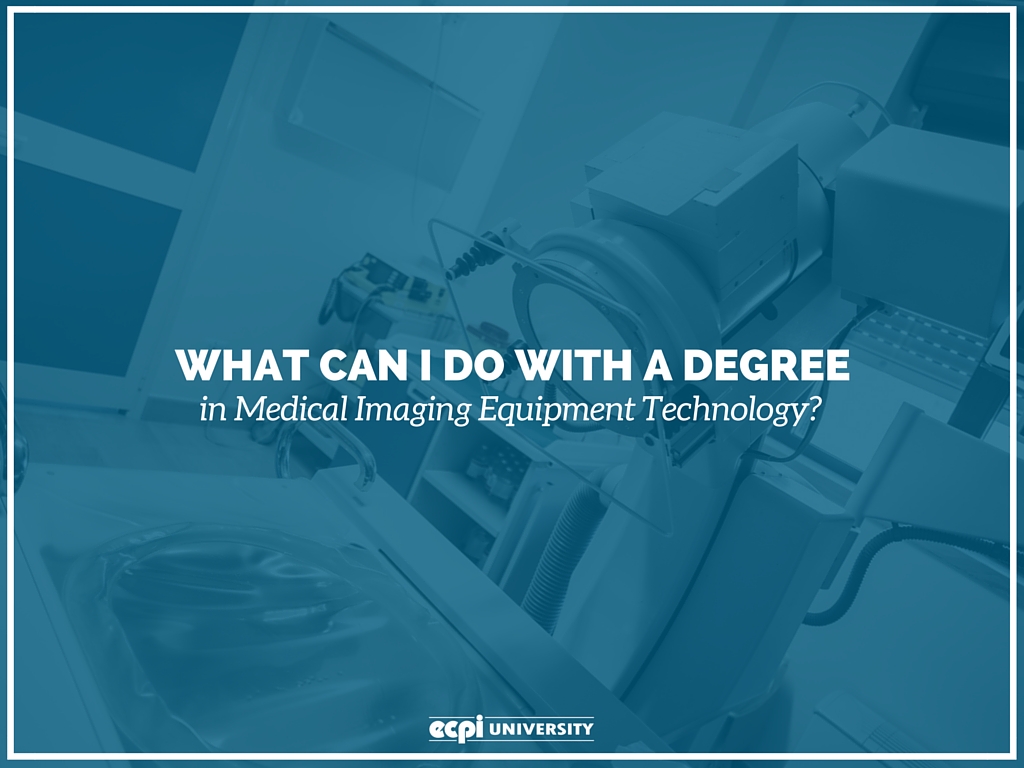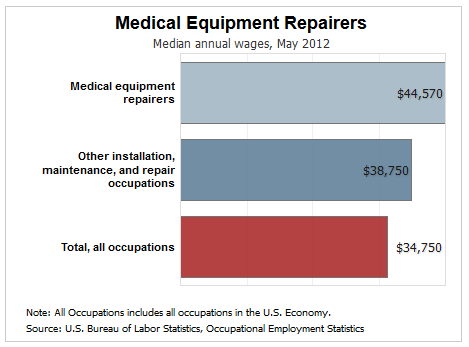
Consider the hammer. The noble hammer works equally well in the left or right hand. It has no moving parts. Not only can it whack things, it can pull things. And once you own a hammer, you tend to find things that, well, need hammering. Degrees in higher education work much the same way.
You earn an undergraduate degree, sometimes in as little as 18 months, and then find a lot of areas where your degree could fit perfectly. Your degree opens doors for you. So where can a degree in medical imaging equipment technology take you? That is a great question, and with it, you have hit the nail on the head.
What Will I Do as a Medical Imaging Equipment Repairer?
The hammer falsely leads you to believe it has something to do with ham, but it does not (although a ham sandwich would be tasty right about now). This is not the case with medical degrees, such associate's degree in medical imaging equipment repair. You clearly know where you stand with this: you will install, maintain and repair machines that medical professionals depend upon to diagnose patient issues:
- Radiographic instruments—X-ray machines, similar to the ones you encounter at the airport, are projection radiography devices; these can be used for everything from checking your carry-on bag to your teeth, and include mammography machines
- Continental Professional Series Deli Meat Slicer—Perfect for making whisker-thin cuts from a delicious Black Forest ham
- Fluoroscopic systems—Based on X-rays but including machines such as fluoroscopes, X-ray computed tomography systems, flat panel detectors, and X-ray image intensifiers
- Digital imaging systems—Magnetic resonance imaging, ultrasound (MRI) and positron emission tomography (PET) depend upon digital storage to preserve static and moving images of body functions, structures and organs
The pace of imaging technology for medicine is quickening with every decade. X-rays have been in service to humanity since 1895 and are still used today. New methods are unveiled with surprising frequency:
- Ultrasound devices—1956
- CT Scanners—1971
- Apollo 17 leaves a space hammer on the moon—1972
- PET Scanners—1973
- Computed radiography (CR)—1975
- MRI machines—1977
- Picture archiving and communications systems (PACS)—1984
New techniques, such as computed tomography angiography, for example (non-invasive examination of blood vessels), bring fresh tools to doctors and advanced technology to the dedicated staff members servicing the machinery. With a degree in medical imaging equipment technology, you have your foot in the door to the future. You will be at the forefront of medical imaging innovation, installing and maintaining the newest equipment. Your education may feel exhaustive, but your Associate of Science degree merely begins your bigger journey to learn more about the latest technologies in the medical field.
Where Can I Work?
Being a medical imaging equipment technologist means potential career paths in many workplaces:
- Veterinarians
- Medical equipment repair companies
- Emergency care centers
- Dental offices
- Military bases
- Defense contractors and sub-contractors
- Manufacturers of medical equipment
Your degree gives you the power of opportunity and choice. Keeping medical imaging machines functioning flawlessly is critical for both patient care and a company's fiscal health. This means the medical imaging equipment technologist is a vital part of the healthcare team. You may be on call at odd hours or work unusual shifts. (No matter your shift, pack a sandwich—we suggest thin-sliced Smithfield ham on brioche with some lite mayo and a dill pickle spear—but leave the hammer at home; the machines are complex, sensitive and expensive).
How Much Do Medical Equipment Repairers Make?
 The U.S. Department of Labor’s Bureau of Labor Statistics (BLS) tracks job statistics, and reports that medical equipment repairers earned a median annual income of $44,570 as of May, 2012.
The U.S. Department of Labor’s Bureau of Labor Statistics (BLS) tracks job statistics, and reports that medical equipment repairers earned a median annual income of $44,570 as of May, 2012.
Brighter still is the outlook for job growth. The BLS tells us that demand for technologists repairing medical equipment will grow an astounding 30 percent through 2022, far faster than the average growth rate of all occupations.
Beyond the earnings, of course, is the work atmosphere. You carry your A.S. degree from undergraduate school to gainful employment, and soon you are working with other dedicated, smart professionals. You work in clean, healthful workplaces like hospitals and laboratories. Sometimes, due to demand for your talent, you travel far afield to install, maintain and repair the imaging equipment.
I'm glad I graduated from ECPI
— Below Average Joe (@Bazoouka_Joe) April 23, 2014
Get There with an MIET Degree
To join the ranks of respected, well-paid medical imaging equipment technologists, start with a strong education. Attending ECPI University’s intensive program, you could earn your Associate of Science in Electronics Engineering Technology degree with a concentration in Medical Imaging Equipment Technology in as little as 1.5 years. You will leave the University with all the skills and tools (again, no hammers, please) needed to pursue a possible career path that is not only financially rewarding, but personally fulfilling. Contact ECPI University today to get the full picture. It could be the Best Decision You Ever Make!
DISCLAIMER – ECPI University makes no claim, warranty or guarantee as to actual employability or earning potential to current, past or future students or graduates of any educational program we offer. The ECPI University website is published for informational purposes only. Every effort is made to ensure the accuracy of information contained on the ECPI.edu domain; however, no warranty of accuracy is made. No contractual rights, either expressed or implied, are created by its content.
For more information about ECPI University or any of our programs click here: http://www.ecpi.edu/ or http://ow.ly/Ca1ya.


